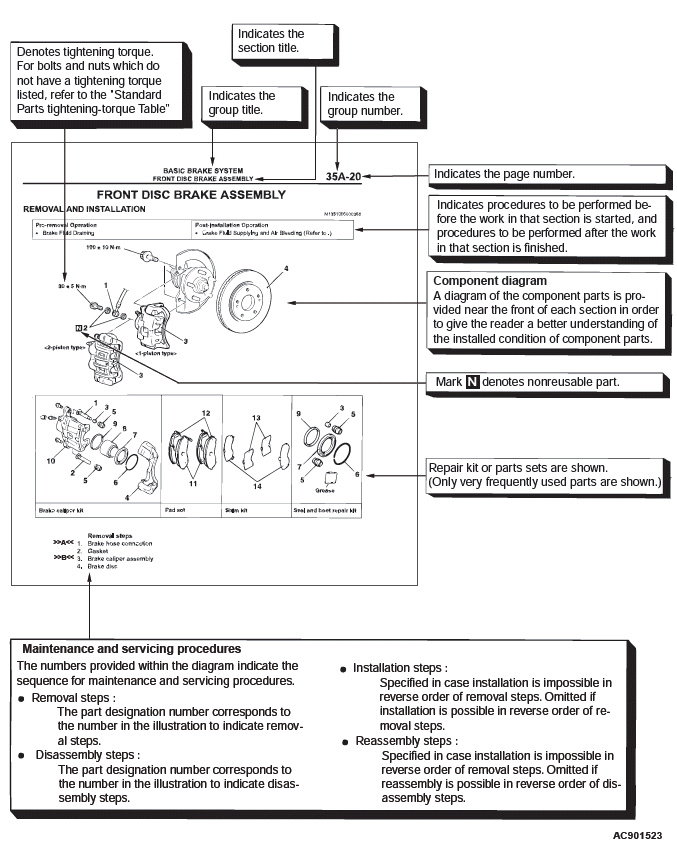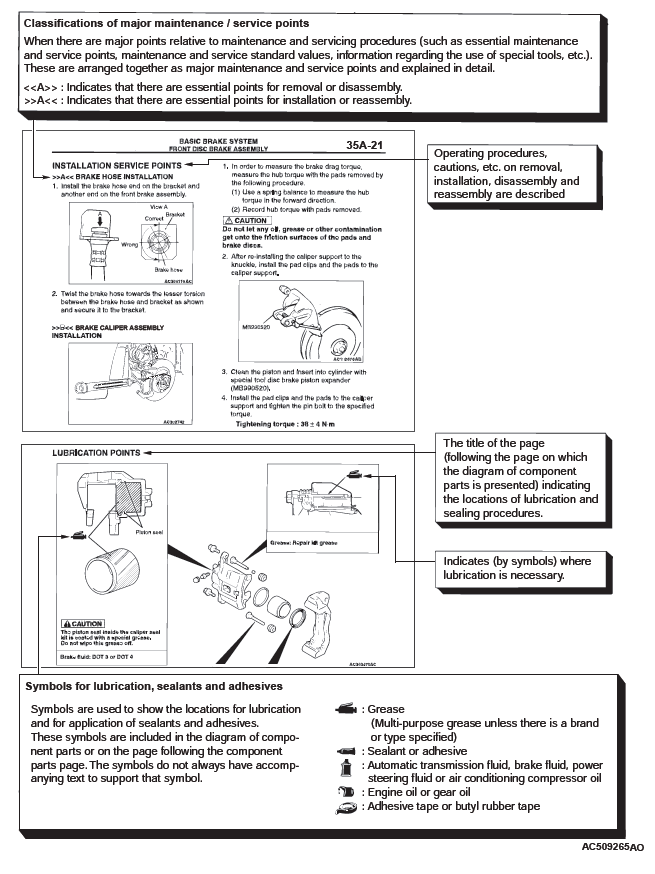Mitsubishi Outlander: How To Use This Manual
MAINTENANCE, REPAIR AND SERVICING EXPLANATIONS
This manual provides explanations, etc. concerning procedures for the inspection, maintenance, repair and servicing of the subject model. Unless otherwise specified, each service procedure covers all models.
Procedures covering specific models are identified by the model codes, or similar designation (engine type, transaxle type, etc.). A description of these designations is covered in this manual under "VEHICLE IDENTIFICATION".
ON-VEHICLE SERVICE
The "ON-VEHICLE SERVICE" section has procedures for performing inspections and adjustments of particularly important components. These procedures are done with regard to maintenance and servicing, but other inspections (looseness, play, cracking, damage, etc.) must also be performed.
SERVICE PROCEDURES
The service steps are arranged in numerical order.
Attention to be paid in performing vehicle service are described in detail in SERVICE POINTS.
DEFINITION OF TERMS
STANDARD VALUE
Indicates the value used as the standard for judging whether or not a part or adjustment is correct.
LIMIT
Shows the maximum or minimum value for judging whether or not a part or adjustment is acceptable.
REFERENCE VALUE
Indicates the adjustment value prior to starting the work (presented in order to facilitate assembly and adjustment procedures, and so they can be completed in a shorter time).
DANGER, WARNING, AND CAUTION
DANGER, WARNING, and CAUTION call special attention to a necessary action or to an action that must be avoided. The differences among DANGER, WARNING, and CAUTION are as follows:
- If a DANGER is not followed, the result is severe bodily harm or even death.
- If a WARNING is not followed, the result could be bodily injury.
- If a CAUTION is not followed, the result could be damage to the vehicle, vehicle components or service equipment.
TIGHTENING TORQUE INDICATION
The tightening torque indicates a median and its tolerance by a unit of N*m (in-lb) or N*m (ft-lb). For fasteners with no assigned torque value.
SPECIAL TOOL NOTE
Only MMC special tool part numbers are called out in the repair sections of this manual. Please refer to the special tool cross-reference chart located at the beginning of each group, for the special tool number that is available in your market.
ABBREVIATIONS
The following abbreviations are used in this manual for classification of model types:
NOTE:
- 2.4L Engine: 2.359 cm3 4B12 engine, or a model equipped with such an engine.
- 3.0L Engine: 2.998 cm3 6B31 engine, or a model equipped with such an engine.
- A/C: Air conditioning.
- A/T: Automatic transaxle, or models equipped with automatic transaxle.
- AWD: All wheel drive vehicles.
- CVT: Indicates the continuously variable transaxle.
- FWD: Front wheel drive vehicles.
- Keyless Operation System (KOS): Free-hand Advanced Security Transmitter (F.A.S.T.-key)
- LIN: Local interconnect network
- MFI: Multiport fuel injection, or engines equipped with multiport fuel injection.
- ECM: Indicates the engine control module
- TCM: Indicates the transaxle control module
EXPLANATION OF MANUAL CONTENTS


Troubleshooting Guidelines
VERIFY THE COMPLAINT
- Make sure the customer's complaint and the service writer's work order description are understood before starting work.
- Make sure the correct operation of the system is understood. Read the service manual description to verify normal system operation.
- Operate the system to see the symptoms. Look for other symptoms that were not reported by the customer, or on the work order, that may be related to the problem.
DETERMINE POSSIBLE CAUSES
Compare the confirmed symptoms to the diagnostic symptom indexes to find the right diagnosis procedure.
If the confirmed symptoms cannot be found on any symptom index, determine other possible causes.
- Analyze the system diagrams and list all possible causes for the problem symptoms.
- Rank all these possible causes in order of probability, based on how much of the system they cover, how likely they are to be the cause, and how easy they will be to check. Be sure to take experience into account. Consider the causes of similar problems seen in the past. The list of causes should be ranked in order from general to specific, from most-likely to least-likely, and from easy-to-check to hard-to-check.
FIND THE PROBLEM
After the symptoms have been confirmed, and probable causes have been identified, the next step is to make step-by-step checks of the suspected system components, junctions, and links in logical order.
Use the diagnostic procedures in the service manual whenever possible. Follow these procedures carefully to avoid missing an important step in the diagnosis sequence. It might be the skipped step that leads to the solution of the problem.
If the service manual doesn't have step-by-step procedures to help diagnose the problem, make a series of checks based on the ranked list of probable causes. Troubleshooting checks should be made in the order that the list of causes was ranked:
- General to specific
- Most-likely to least-likely
- Easy-to-check to hard-to-check
REPAIR THE PROBLEM
When the step-by-step troubleshooting checks find a fault, perform the proper repairs. Make sure to fix the root cause of the problem, not just the symptom. Just fixing the symptom, without fixing the root cause, will cause the symptom to eventually return.
VERIFY THE REPAIR
After repairs are made, recheck the operation of the system to confirm that the problem is eliminated. Be sure to check the system thoroughly. Sometimes new problems are revealed after repairs have been made.

